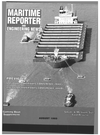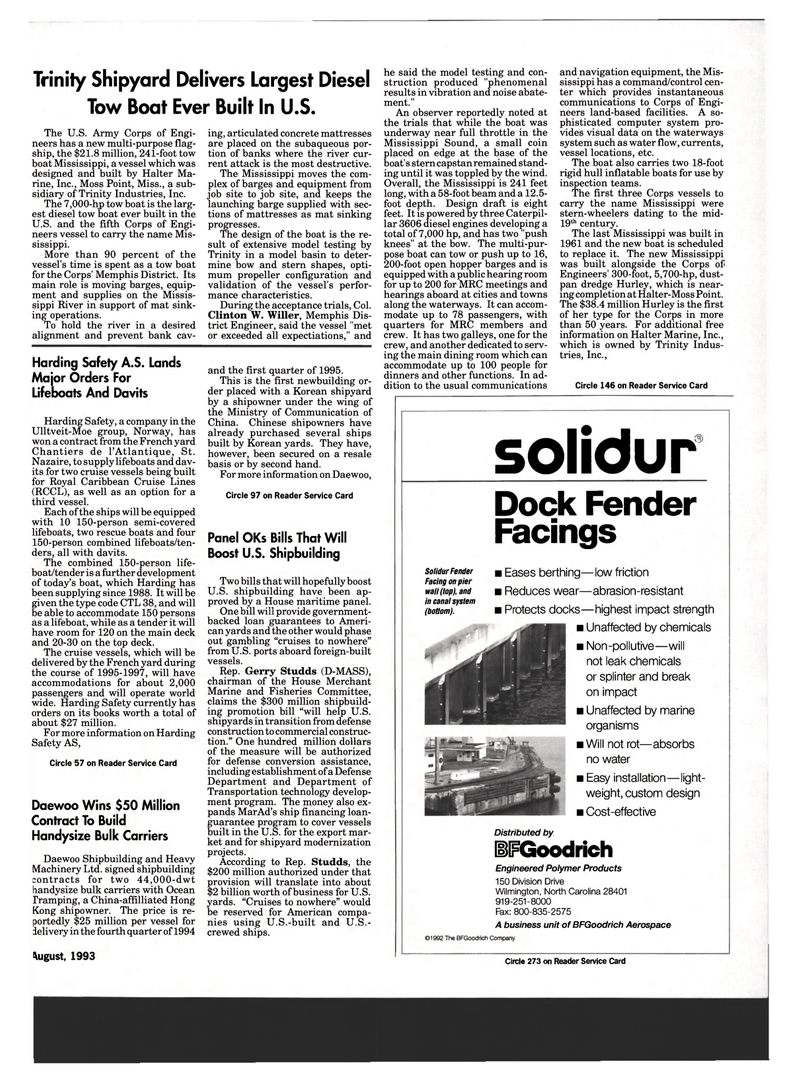
Page 9: of Maritime Reporter Magazine (August 1993)
Read this page in Pdf, Flash or Html5 edition of August 1993 Maritime Reporter Magazine
Trinity Shipyard Delivers Largest Diesel
Tow Boat Ever Built In U.S.
The U.S. Army Corps of Engi- neers has a new multi-purpose flag- ship, the $21.8 million, 241-foot tow boat Mississippi, a vessel which was designed and built by Halter Ma- rine, Inc., Moss Point, Miss., a sub- sidiary of Trinity Industries, Inc.
The 7,000-hp tow boat is the larg- est diesel tow boat ever built in the
U.S. and the fifth Corps of Engi- neers vessel to carry the name Mis- sissippi.
More than 90 percent of the vessel's time is spent as a tow boat for the Corps' Memphis District. Its main role is moving barges, equip- ment and supplies on the Missis- sippi River in support of mat sink- ing operations.
To hold the river in a desired alignment and prevent bank cav-
Harding Safety A.S. Lands
Major Orders For
Lifeboats And Davits
Harding Safety, a company in the
Ulltveit-Moe group, Norway, has won a contract from the French yard
Chantiers de l'Atlantique, St.
Nazaire, to supply lifeboats and dav- its for two cruise vessels being built for Royal Caribbean Cruise Lines (RCCL), as well as an option for a third vessel.
Each of the ships will be equipped with 10 150-person semi-covered lifeboats, two rescue boats and four 150-person combined lifeboats/ten- ders, all with davits.
The combined 150-person life- boat/tender is a further development of today's boat, which Harding has been supplying since 1988. It will be given the type code CTL 38, and will be able to accommodate 150 persons as a lifeboat, while as a tender it will have room for 120 on the main deck and 20-30 on the top deck.
The cruise vessels, which will be delivered by the French yard during the course of 1995-1997, will have accommodations for about 2,000 passengers and will operate world wide. Harding Safety currently has orders on its books worth a total of about $27 million.
For more information on Harding
Safety AS,
Circle 57 on Reader Service Card
Daewoo Wins $50 Million
Contract To Build
Handysize Bulk Carriers
Daewoo Shipbuilding and Heavy
Machinery Ltd. signed shipbuilding contracts for two 44,000-dwt handysize bulk carriers with Ocean
Tramping, a China-affilliated Hong
Kong shipowner. The price is re- portedly $25 million per vessel for delivery in the fourth quarter of 1994 ing, articulated concrete mattresses are placed on the subaqueous por- tion of banks where the river cur- rent attack is the most destructive.
The Mississippi moves the com- plex of barges and equipment from job site to job site, and keeps the launching barge supplied with sec- tions of mattresses as mat sinking progresses.
The design of the boat is the re- sult of extensive model testing by
Trinity in a model basin to deter- mine bow and stern shapes, opti- mum propeller configuration and validation of the vessel's perfor- mance characteristics.
During the acceptance trials, Col.
Clinton W. Wilier, Memphis Dis- trict Engineer, said the vessel "met or exceeded all expectiations," and and the first quarter of 1995.
This is the first newbuilding or- der placed with a Korean shipyard by a shipowner under the wing of the Ministry of Communication of
China. Chinese shipowners have already purchased several ships built by Korean yards. They have, however, been secured on a resale basis or by second hand.
For more information on Daewoo,
Circle 97 on Reader Service Card
Panel OKs Bills That Will
Boost U.S. Shipbuilding
Two bills that will hopefully boost
U.S. shipbuilding have been ap- proved by a House maritime panel.
One bill will provide government- backed loan guarantees to Ameri- can yards and the other would phase out gambling "cruises to nowhere" from U.S. ports aboard foreign-built vessels
Rep." Gerry Studds (D-MASS), chairman of the House Merchant
Marine and Fisheries Committee, claims the $300 million shipbuild- ing promotion bill "will help U.S. shipyards in transition from defense construction to commercial construc- tion." One hundred million dollars of the measure will be authorized for defense conversion assistance, including establishment of a Defense
Department and Department of
Transportation technology develop- ment program. The money also ex- pands MarAd's ship financing loan- guarantee program to cover vessels built in the U.S. for the export mar- ket and for shipyard modernization projects.
According to Rep. Studds, the $200 million authorized under that provision will translate into about $2 billion worth of business for U.S. yards. "Cruises to nowhere" would be reserved for American compa- nies using U.S.-built and U.S.- crewed ships. he said the model testing and con- struction produced "phenomenal results in vibration and noise abate- ment."
An observer reportedly noted at the trials that while the boat was underway near full throttle in the
Mississippi Sound, a small coin placed on edge at the base of the boat's stern capstan remained stand- ing until it was toppled by the wind.
Overall, the Mississippi is 241 feet long, with a 58-foot beam and a 12.5- foot depth. Design draft is eight feet. It is powered by three Caterpil- lar 3606 diesel engines developing a total of 7,000 hp, and has two "push knees" at the bow. The multi-pur- pose boat can tow or push up to 16, 200-foot open hopper barges and is equipped with a public hearing room for up to 200 for MRC meetings and hearings aboard at cities and towns along the waterways. It can accom- modate up to 78 passengers, with quarters for MRC members and crew. It has two galleys, one for the crew, and another dedicated to serv- ing the main dining room which can accommodate up to 100 people for dinners and other functions. In ad- dition to the usual communications and navigation equipment, the Mis- sissippi has a command/control cen- ter which provides instantaneous communications to Corps of Engi- neers land-based facilities. A so- phisticated computer system pro- vides visual data on the waterways system such as water flow, currents, vessel locations, etc.
The boat also carries two 18-foot rigid hull inflatable boats for use by inspection teams.
The first three Corps vessels to carry the name Mississippi were stern-wheelers dating to the mid- 19th century.
The last Mississippi was built in 1961 and the new boat is scheduled to replace it. The new Mississippi was built alongside the Corps of
Engineers' 300-foot, 5,700-hp, dust- pan dredge Hurley, which is near- ing completion at Halter-Moss Point.
The $38.4 million Hurley is the first of her type for the Corps in more than 50 years. For additional free information on Halter Marine, Inc., which is owned by Trinity Indus- tries, Inc.,
Circle 146 on Reader Service Card solidur
Dock Fender Facings • Easy installation—light- weight, custom design • Cost-effective
Distributed by lIFGoodrich
Engineered Polymer Products 150 Division Drive
Wilmington, North Carolina 28401 919-251-8000
Rax: 800-835-2575
A business unit of BFGoodrich Aerospace ©1992 The BFGoodrich Company
Solidur Fender
Facing on pier wall (top), and in canal system (bottom). • Eases berthing—low friction • Reduces wear—abrasion-resistant • Protects docks—highest impact strength • Unaffected by chemicals • Non-pollutive—will not leak chemicals or splinter and break on impact • Unaffected by marine organisms • Will not rot—absorbs no water
August, 1993 Circle 273 on Reader Service Card

 8
8

 10
10
